-
Welcome back Guest! Did you know you can mentor other members here at H-M? If not, please check out our Relaunch of Hobby Machinist Mentoring Program!
You are using an out of date browser. It may not display this or other websites correctly.
You should upgrade or use an alternative browser.
You should upgrade or use an alternative browser.
Group Project: Dividing Head - The Build
- Thread starter Flyinfool
- Start date
- Joined
- Aug 13, 2020
- Messages
- 1,342
I've been working on the base components steadily, but most of the work has been updating the tools to make the tool. Since I've last checked in, I replaced my 12x36 Craftsman/Atlas lathe with a 1942 vintage16x48 Sebastian. The RF-45 clone benchtop mill has been replaced with a Bridgeport clone. Lots of learning along the way, as neither upgrade was smooth, but required significant "repairs". But, the increase in power and rigidity has resulted in better finishes.
Today, I was going to ask for help on how to use the rotary table. I've got a 12" Bridgeport table, but I've never once used it. To make the question clear, I was going to post part of the drawing. When I looked at the drawing, it hit me like a ton of bricks. The bore for the trunnion is supposed to be 2.750". . . not the 3.000" that I've carefully bored into each of these.
I'm starting to detect a pattern here. And it ain't good.
Today, I was going to ask for help on how to use the rotary table. I've got a 12" Bridgeport table, but I've never once used it. To make the question clear, I was going to post part of the drawing. When I looked at the drawing, it hit me like a ton of bricks. The bore for the trunnion is supposed to be 2.750". . . not the 3.000" that I've carefully bored into each of these.
I'm starting to detect a pattern here. And it ain't good.
- Joined
- Sep 8, 2019
- Messages
- 4,392
I still have the spindles ready to go!
- Joined
- Mar 25, 2013
- Messages
- 4,614
It's not exactly to the plan specs but I think I have a functional 40 tooth worm gear:
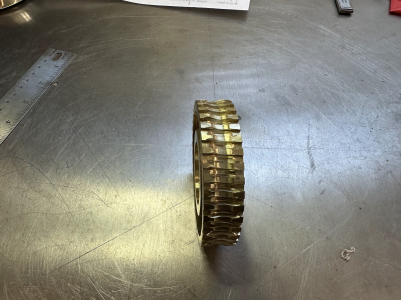
Stop reading here is you don't want the long version!
I ran into problems and learned a few things. My plan for making this was to make a hob by cutting slots into the acme lead screw (kind of like a tap with flutes.) I was hoping the hob would cause the gear blank to passively rotate as it cut the teeth.
I started off by removing material from the center and cutting slots in the 3.6" diameter blank:
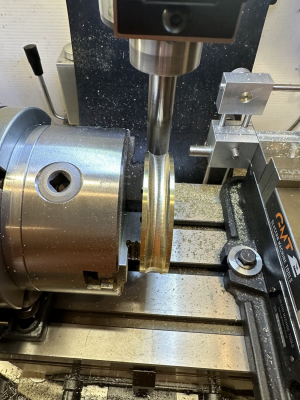
I used a 3/4" end mill to get close to the minor diameter of a 1-4 acme screw.
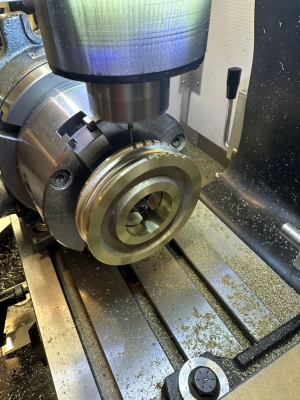
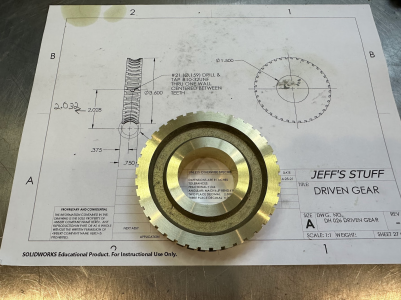
I then mounted the blank on ball bearings attached to this table I made. This positions the blank at the correct height on my lathe:
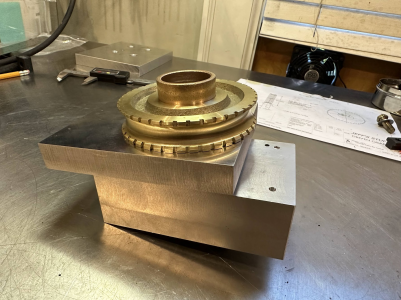
Like so:
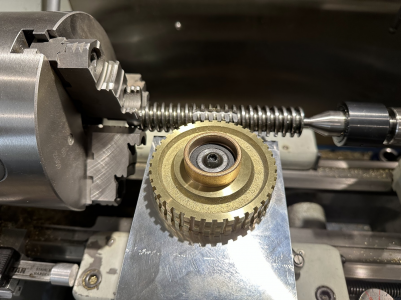
This first attempt WAS A TOTAL FAIL!
The hob simply would not follow the grooves I cut and was "cross threading" with the teeth. After much thought and gnashing of teeth (my teeth) I came up with this theory. The blank diameter of 3.6" may be ideal in theory but the depth of tooth and coverage of the screw that geometry creates is just too ambitious for my home made hob. Here's why- the pitch of the lead screw is 4 TPI or .25". When you start to cut the OD of the 3.6" blank you cannot physically have a .25 pitch and a 3.6" gear. The circumference is too large and the hob wants to make a 43 tooth gear or so. In fact I calculate the pitch for a 3.6" gear at .2826" For small gears with large teeth this becomes a problem. If the tooth depth is a much smaller percentage of the gear diameter then the change inpitch circumference from the OD to the pitch diameter is not so much of an issue.
After ruining the first blank I decided to machine off the bad teeth and start with a smaller OD blank. I machined it down to 3.4" diameter and recut shallow grooves with a 1/8" end mill. This actually worked as planned! The hob cut the center of the blank and turned the blank as it cut.
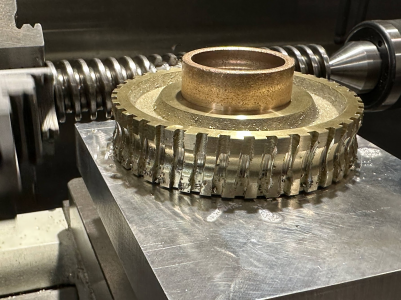
Try this link?: https://photos.app.goo.gl/97AEtNLx19TU22XJ7
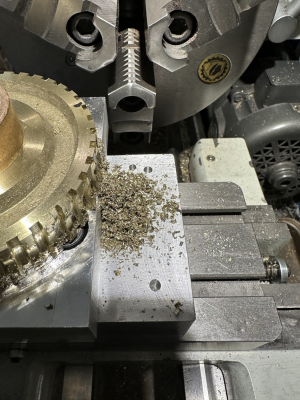
So the tooth depth is not as much as spec but it is adequate to smoothly drive the gear. The tooth coverage does not extend all the way to the edges of the gear, but again, it is adequate. Tooth spacing appears to be excellent (which is critical.)
The hob is now not cutting well. I may try to modify the teeth to make it more functional. I may also make a specific acme tooth shaped cutter and try cutting each tooth individually, then follow up with the hob. It would be great if I could get the teeth about 50 thou deeper. Or I could quit here and call it a win!
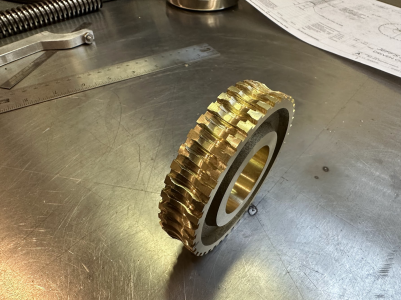

Stop reading here is you don't want the long version!
I ran into problems and learned a few things. My plan for making this was to make a hob by cutting slots into the acme lead screw (kind of like a tap with flutes.) I was hoping the hob would cause the gear blank to passively rotate as it cut the teeth.
I started off by removing material from the center and cutting slots in the 3.6" diameter blank:

I used a 3/4" end mill to get close to the minor diameter of a 1-4 acme screw.


I then mounted the blank on ball bearings attached to this table I made. This positions the blank at the correct height on my lathe:

Like so:

This first attempt WAS A TOTAL FAIL!
The hob simply would not follow the grooves I cut and was "cross threading" with the teeth. After much thought and gnashing of teeth (my teeth) I came up with this theory. The blank diameter of 3.6" may be ideal in theory but the depth of tooth and coverage of the screw that geometry creates is just too ambitious for my home made hob. Here's why- the pitch of the lead screw is 4 TPI or .25". When you start to cut the OD of the 3.6" blank you cannot physically have a .25 pitch and a 3.6" gear. The circumference is too large and the hob wants to make a 43 tooth gear or so. In fact I calculate the pitch for a 3.6" gear at .2826" For small gears with large teeth this becomes a problem. If the tooth depth is a much smaller percentage of the gear diameter then the change in
After ruining the first blank I decided to machine off the bad teeth and start with a smaller OD blank. I machined it down to 3.4" diameter and recut shallow grooves with a 1/8" end mill. This actually worked as planned! The hob cut the center of the blank and turned the blank as it cut.

Try this link?: https://photos.app.goo.gl/97AEtNLx19TU22XJ7

So the tooth depth is not as much as spec but it is adequate to smoothly drive the gear. The tooth coverage does not extend all the way to the edges of the gear, but again, it is adequate. Tooth spacing appears to be excellent (which is critical.)
The hob is now not cutting well. I may try to modify the teeth to make it more functional. I may also make a specific acme tooth shaped cutter and try cutting each tooth individually, then follow up with the hob. It would be great if I could get the teeth about 50 thou deeper. Or I could quit here and call it a win!

Last edited:
- Joined
- Aug 13, 2020
- Messages
- 1,342
I'd call it a win. The way I see it, the teeth will only ever be engaged with hand control, turn extremely slowly, and under practically no pressure.
Close tolerance is crucial. Being able to pull the Titanic, not so much. The device should be locked before cutting starts. Right? Yes? No?
Close tolerance is crucial. Being able to pull the Titanic, not so much. The device should be locked before cutting starts. Right? Yes? No?
- Joined
- Mar 25, 2013
- Messages
- 4,614
I made a cutter out of O1 tool steel. It has the profile of an Acme 1-4 thread. I hardened and tempered it:
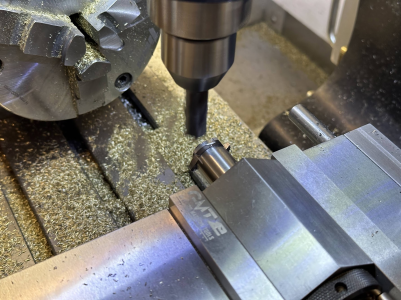
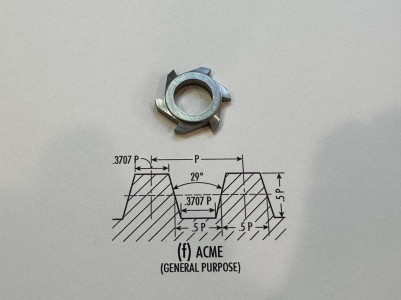
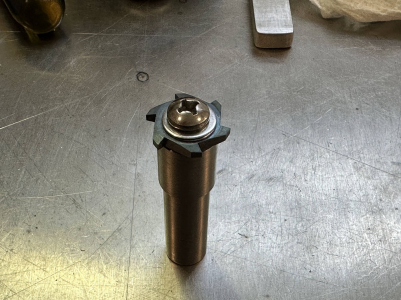
I used this cutter to pre-notch the gear blank:
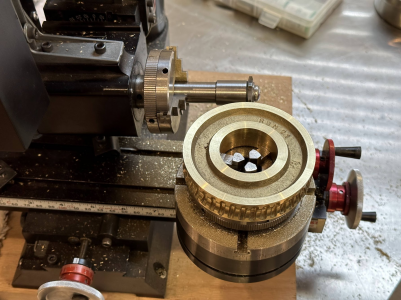
I then put it back on the lathe and finished with the hob:
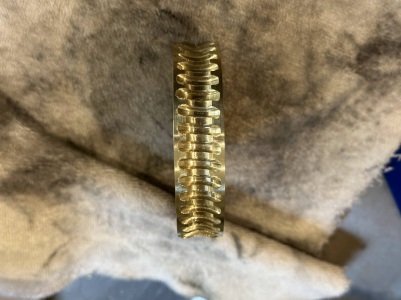
This one has a few messed up teeth (not shown). Unfortunately this process is very tedious I also cannot get my hob to cut very deep so a real cutter would probably work out better. Also, the steel of my hob is not very hard so it dulls fast even with brass. I thought about case hardening it but I am afraid to bend the shaft. I cannot make a hob out of tool steel 'cause my lathe won't cut 4 TPI!



I used this cutter to pre-notch the gear blank:

I then put it back on the lathe and finished with the hob:

This one has a few messed up teeth (not shown). Unfortunately this process is very tedious I also cannot get my hob to cut very deep so a real cutter would probably work out better. Also, the steel of my hob is not very hard so it dulls fast even with brass. I thought about case hardening it but I am afraid to bend the shaft. I cannot make a hob out of tool steel 'cause my lathe won't cut 4 TPI!
Last edited:

